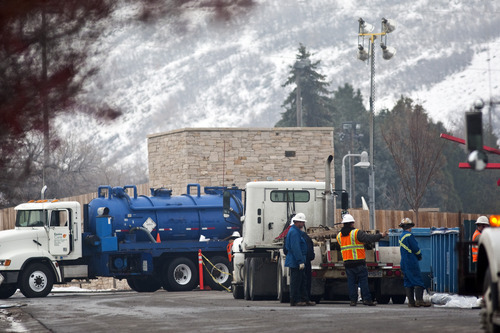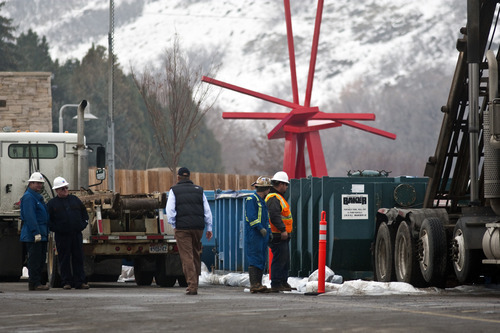This is an archived article that was published on sltrib.com in 2010, and information in the article may be outdated. It is provided only for personal research purposes and may not be reprinted.
More than a few people began to wonder this past week whether the Salt Lake Valley really is, to borrow a phrase from Brigham Young, the right place for a crude-oil pipeline.
The questions began to surface after a second pipeline break in six months dumped hundreds of barrels of oil at the Red Butte botanical garden in the eastern foothills of Utah's most populated city.
As many as 500 barrels of crude spilled Wednesday from a valve box and threatened to bring a new round of health risks and environmental damage.
Meanwhile, the restoration is not even finished from the spill of 800 barrels that poured down Red Butte Creek in June, puddled in the Liberty Park pond and leaked into the Jordan River. The spill locations are 100 yards apart.
Whether this leak and June's spill are related is still unknown. Also undetermined is the cause — whether it was a manufacturing defect, an electronic glitch or operator error.
Chevron cleanup crews by Monday are expected to have cleaned up the oil and scraped up about 1½ inches of contaminated soil at the spill site. It is also possible that pipeline safety investigators will be able to get to work in the concrete catchment where the latest leak occurred.
The monitoring of Red Butte Creek water is expected to continue, as is soil sampling. Environmental quality officials want to make sure that, despite the speedy cleanup this time, no hazardous chemicals from the oil have leached into the water.
Whatever the investigation's outcome, few think it likely federal regulators will order the pipeline moved or shut down permanently.
Julia Valentine, spokeswoman for the U.S. Department of Transportation's Pipeline and Hazardous Materials Safety Administration, said her agency has "clear authority" to idle a dangerous pipeline.
"PHMSA can keep any pipeline from operating that is not doing so safely," she said. The agency can "restrict operations and require other action the agency deems necessary to protect the safety of people and the environment."
Safety advocates say both tough overseers and citizen watchdogs are necessary to ensure that people and hazardous-material pipelines can coexist in populated areas.
Lois Epstein, a pipeline safety expert and engineer who works for the Wilderness Society in Alaska, noted that many pipelines were built during a time when the risk to populated communities was considered negligible.
As communities have grown, they've closed in on— and sometimes built over — lines that move hazardous materials, at some risk to the land and people. The Chevron pipeline running through Salt Lake City is more than 60 years old.
"I don't think there are any good alternatives," added Epstein, noting that shipping oil by trucks is considered less safe. "You have to make sure pipelines are well-designed, well-maintained and well-operated, and that requires sufficient resources by the operator."
Epstein also said the federal pipeline safety office must "fine the operator sufficiently" to avert problems.
In the case of Chevron's June spill at Red Butte, the fine was paid electronically on Thursday without the company admitting "the accuracy of [federal regulators'] allegations or [their] factual assertions." As for last week's spill, state and/or federal violation notices are probably weeks away.
Fred Millar, a Washington, D.C.-based advocate for safe shipping of hazardous materials, agreed that robust oversight is essential. But he expressed doubts about the pipeline safety office's ability to be tough.
He pointed to a September 2009 congressional hearing, where Rep. James L. Oberstar, D-Minn., chairman of the House Transportation and Infrastructure Committee, criticized PHMSA's record.
Oberstar cited investigations that found "a shocking number of failures by PHMSA to follow federal law in hazmat regulation, as well as outright neglect in regulating the transport of hazmat [and testimony from PHMSA employees] that their own agency was entirely too 'cozy' with the industry."
"It is clear that PHMSA needs to rethink its relationship with the industry it regulates," Oberstar said, "and it needs comprehensive, top-to-bottom reform of its procedures and processes. The current state of PHMSA is completely unacceptable."
For Millar, the needed reforms are important, but they also underscore the public's watchdog role.
He said citizens should be able to review the pipeline agency's maps, emergency plans and details about the contents of the goods being transported. Without that sunshine, the public will be stuck in the dark, having little more than blind trust that they will be protected from hazards in their midst.
And that won't be easy to accept, Millar said. "We've had this whole series of disasters where we find federal oversight is a wreck."
Yalecrest resident and biology teacher Peter Hayes pressed Chevron Pipe Line Co. at a news conference Thursday about the Salt Lake City pipeline's future. He wanted to know if the company "is seriously considering" moving it.
Mark Sullivan, Chevron's Salt Lake City refinery manager, responded that pipeline locations are continually under review and that the company understands the public's trust has been badly damaged.
"I understand their concern about our ability to operate our facilities," Sullivan said. "I understand their deep concern about whether or not they can trust me to be able to operate my refinery or the pipeline safely. I know that I can do that. I know that I have done that in the past. …
"I am confident I can restore the public's confidence," he continued. "However, I fully expect that will be very difficult given two very close recent occurrences."
An outraged Salt Lake City Mayor Ralph Becker indicated trust alone would no longer be enough. He urged federal pipeline safety officials to press their investigation and also to keep the pipeline shut down until an "independent study has been completed and all potential security concerns addressed."
Becker is scheduled to meet with federal oversight officials in Washington Monday morning.
Hazardous spills primer
Corrine Brown, chairwoman of the House Subcommittee on Railroads, Pipelines and Hazardous Materials, included these facts in her opening statement at a September 2009 congressional hearing on problems at the federal Pipeline and Hazardous Materials Safety Administration (PHMSA), the agency that oversees the Chevron pipeline that spilled nearly 55,000 gallons of crude oil in Salt Lake City in two incidents in the past six months.
Nearly 1.2 million shipments of hazardous materials are moved by all modes of transportation each day.
More than 170,000 incidents in the past decade have involved the transportation of hazardous materials.
The incidents resulted in 134 fatalities, 2,783 injuries and more than $631 million in property damage.
There are 35 pipeline safety inspectors to cover over 300,000 hazmat-related entities.





